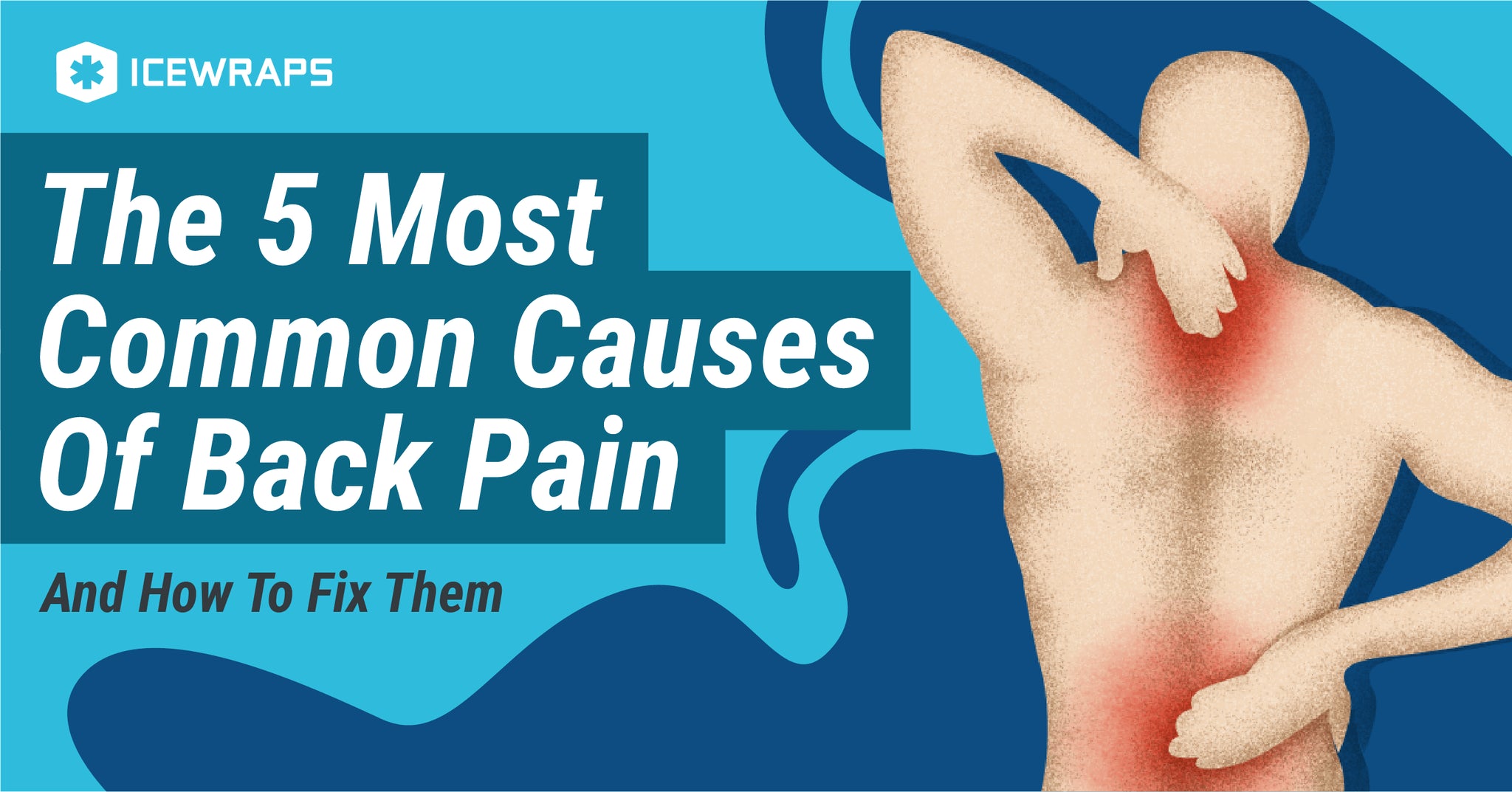Your Cart is Empty

Contents
Suffering from back pain? You’re not alone. This condition has been plaguing millions of Americans for decades. Studies even show that back pain is one of the most common reasons why people miss work each year. It’s also the third most common reason why people visit the doctor, next only to skin disorders and joint problems.
Fact is, 8 in 10 people suffer from back pain. If you’re part of that statistic, you’ll know that enduring this discomfort is no easy task. Thankfully, there are solutions to this prevalent problem.
In this article, we pinpoint the top 5 causes of back pain and what you can do to fix them.
If you’re eager to rid yourself of back pain, let’s dive right in:
First order of business: get to know your back.  This particular part of your body is way more complex than it looks: it’s made up of bones, nerves, muscles, ligaments, and cartilage that work together to keep you upright and moving. To understand the causes of back pain, you also have to understand how these parts work.
This particular part of your body is way more complex than it looks: it’s made up of bones, nerves, muscles, ligaments, and cartilage that work together to keep you upright and moving. To understand the causes of back pain, you also have to understand how these parts work.
Let’s start off with your spinal column.
Lots of folks mistake the spinal column for the spinal cord. Don’t be confused. The spinal cord is a bunch of nerves that control most of your motor functions. Your spinal column, on the other hand, is the series of bones that protect the spinal cord.
The spinal column is, in turn, made up of 33 small, interlocking bones called vertebrae. Between each vertebra, you can find the spinal disc, which keeps your vertebrae from rubbing and grinding against each other. Spinal discs are made of fibrous material on the outside and are fluid and gel-like on the inside.
Supporting your spine are a bunch of striated or striped muscles. These muscles are also responsible for the movement of your back, shoulders, and backside. They allow you to lift, bend, twist, flex and maintain an upright proper posture.
Back pain usually happens when any of these parts get hurt or damaged. It can be due to a slew of reasons, which can range from bad habits to serious organ damage.
Let’s break them down one by one. When it comes to back pain, here are the most common culprits:
When it comes to the main cause of back pain, look no further than bad bending habits.
Lots of folks--- especially Americans--- tend to bend at the waist rather than the hips, forming a "c" shape and putting unnecessary strain on their backs. Your vertebrae aren't built for this kind of stress. Bending this way can erode your spinal discs or cause them to protrude or herniate. This also causes your back and neck muscles to become sore and stiff.
Western folks can take a hint from traditional societies in Africa and Asia when it comes to bending the right way. Reports show that people who live in traditional and agricultural societies in these parts of the globe report little to no back pain throughout their lifespans.
Here’s their secret: instead of slouching forward and bending at the waist, these people would do the hip hinge.
Hip hinging is simply bending at the hips while keeping a straight back. Unlike your spine, your hip joint is designed to handle a lot of stress and movement. Bending at the hips transfers the weight and pressure from your back to your hip joint.
To do the hip hinge, simply keep your back straight and bend from your hips. Bend your knees to engage your thigh and glutes while you’re at it. Practice this movement whenever you pick up something from the ground. You’ll see and feel the difference in no time!
Surprise! Leading a non-active lifestyle can take its toll on your spine. If you avoid exercise and similar activities like the plague, chances are your muscles will lose their elasticity and tone. They’ll be prone to strains and will most likely be unable to support your spine properly.
Putting on extra pounds, especially around your belly, can pull your spine forward and throw off your posture, alignment, and center of gravity. On top of back pain, this can also put additional strain on your weight-bearing joints like your ankles and knees.
Thankfully, the solution is pretty simple: get moving! Regular exercise can do wonders to your back. You don’t even have to go to the gym every day if you’re unable to. Simple exercises like walking, doing back stretches, and some gentle yoga can help strengthen and tone your back muscles.
Take the stairs instead of the elevator the next time you go to work. Don’t forget to flex your glutes while you’re at it--- those muscles in your backside play a huge part in supporting your spine, so you have to keep them toned.
If you spend long hours sitting in front of your computer, take regular “stretch” breaks every thirty minutes to loosen up those tight muscles and joints. Roll your shoulders back ten times and then forward for the same duration.
You can also do these easy but helpful 1-minute exercises before you start your day.
And of course, don’t forget to maintain a healthy weight to avoid straining your back and joints, and to avoid a myriad of other health problems as well.
A lot of people blame back pain on sudden, excessive movement but the truth of the matter is that most back pains are actually caused by small, everyday stressors like bad posture.
Look, we’re all guilty of slouching at some point in our lives. The thing is, this bad habit causes upper back pain and puts us at risk for spinal deformities later in life.
Other “small” things like using bad office furniture or ill-fitting shoes can also cause back pain in the long run. Studies even show that men tend to suffer from lower back pain simply because they put their wallets in their back pockets. These might seem like small inconveniences, but they could be quite dangerous when they add up.
Old habits die hard, but with lots of determination, you can kick these bad practices to the curb and make room for new, healthy ones.
For better posture, try to be mindful of your spine at all times. Refrain from hunching your shoulders forward. Instead, they should be kept back and relaxed, with your arms on the sides. Your thumbs should be pointing outwards.
Practice lengthening your spine. Take a deep breath and feel your spine grow taller. Hold this position for as long as you can. Take care not to arch your back, though.
Core exercises are also good for your back. Strong abdominal muscles make for better posture. Try doing lunges, crunches, and squats for a stronger core.
Aside from working on your posture and fitness, take note of the little things that might cause your back pain. For example, if you’re sitting in the office all day, make sure that your desk or chair is ergonomic and of the right height. Your forearms should rest at a right angle when you’re working on your desk. Your feet be planted firmly on the floor. Your chair should also come with a backrest that adequately supports your lower back.
As mentioned earlier, keeping your wallet in your back pocket can mess up your spine’s alignment, with one butt cheek higher than the other. Try putting that wallet in your front pockets instead. It will sure take a while to get used to, but you’ll thank us later.
Some people are at risk for back pain more than others. This includes those who work in jobs that require heavy lifting, like nurses, factory workers, weightlifters or those in logistics. Sudden or constant strain on your back causes sore muscles, strained ligaments or even ruptured disks.
Always put safety first, especially if your line of work involves a lot of heavy lifting. Aside from doing exercises to strengthen your back, you must also practice proper body mechanics when lifting and moving things.
As a general rule, you must always:
Back pain may not be limited to the causes we’ve noted above. Sometimes, back pain can be an indication of kidney trouble or it could also be related to heart or lung problems. Other times, it can be caused by other bone and nerve conditions like osteoporosis and scoliosis.
Another common nerve problem associated with back pain is sciatica. This condition occurs when your sciatic nerve gets compressed. Pain begins from your lower back and creeps down to your legs. This can be aggravated by other factors like age and smoking.
Depression can also contribute to back pain. Many patients who suffer from depression and anxiety also experience chronic aches and pains all over their body.
First, you will need to consult with your healthcare provider if you have any underlying conditions related to your back pain, especially if it’s related to your major systems. They will do a thorough evaluation and will recommend a plan of care specific to your needs.
If you’re suffering from nerve problems like sciatica, the exercises in the video above might be helpful in treating the condition at home.
If you’ve been hit by a bout of back pain at home, you can always turn to hot and cold therapy. This is an inexpensive and drug-free way to lessen the burden of back pain.
For sore muscles or swollen joints, a cold compress will do just the trick. The cool temperature will constrict your blood vessels and will help lessen pain and inflammation.
If you’re suffering from stiff muscles and chronic pains, however, you’ll want to use a warm compress. Warmth helps relax muscles and improve blood flow to the area.
Now, you don’t need to stretch and place a hot water bottle or an ice bag over your back if you’re suffering from pain. A hot and cold compression wrap will stay in place and deliver adequate temperature while still letting you go about your daily activities. If you’re experiencing back pain, a nice compression wrap will surely help you heal faster.
 |
| ICEWRAPS 12X21 OVERSIZE COLD THERAPY CLAY PACK WITH COVER |
 |
Aside from hot and cold therapy, you can also try going to a chiropractor for spinal adjustments. Chiropractors help realign your spine by releasing the lactic acid trapped between your vertebrae. Lots of people have benefited from chiropractic adjustments. Be sure to consult with your primary care provider before scheduling a session, though!
No one likes to suffer from back pain--- and you shouldn’t have to endure it. Take note of these common causes and do your best to fix them. With the right treatment plan, determination and help from a solid support system, you can free yourself from the burdens of back pain in no time.
Which one of these causes are you going to tackle first? Let us know in the comments below!
Comments will be approved before showing up.